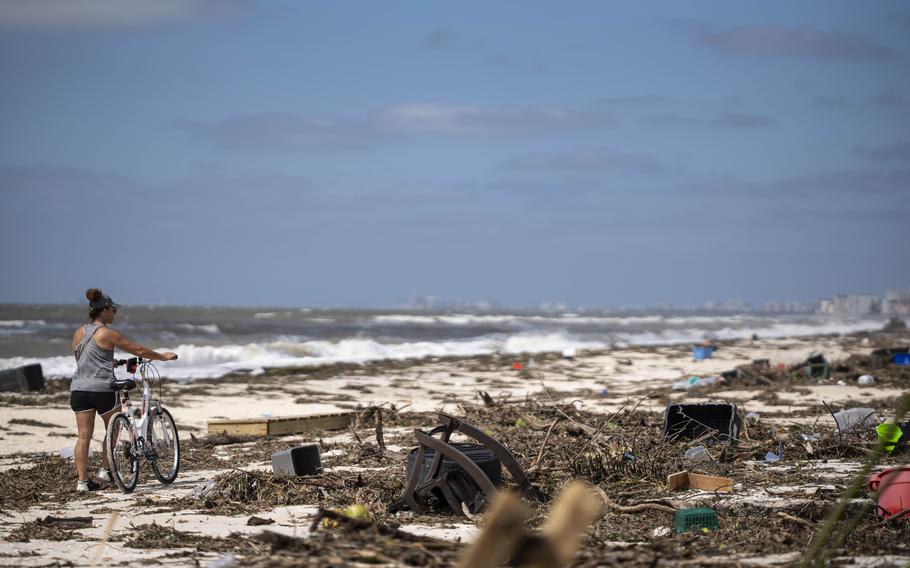
Debris from storm damage covers the beach after Hurricane Ian ravaged Bonita Springs, Fla., in September 2022. (Thomas Simonetti/The Washington Post)
Global greenhouse gas levels set a record in 2022, keeping the planet’s temperatures on a rising path set to blow past the world’s climate goals, the U.N. World Meteorological Organization said in a report Wednesday.
There is “no end in sight” for growth in greenhouse gas emissions, the World Meteorological Organization (WMO) warned, reporting that global concentrations for carbon dioxide, methane and nitrous oxide climbed to new highs last year. The emissions of these heat-trapping gases broke records as the planet continued on a trajectory that scientists have said will probably lead to major and irreversible damage to ecosystems and communities.
“We are seeing new, extremely high levels of the three main gases,” which drive the rising global temperature and extreme weather events, WMO senior scientific officer Oksana Tarasova told The Washington Post.
The WMO’s data analyzes measurements from 150 observation stations across the globe. The record greenhouse gases levels in 2022 offer another urgent metric ahead of the COP28 climate conference this month in Dubai. Last year was the planet’s fifth-hottest, according to the European Union’s Copernicus Climate Change Service, and carbon dioxide levels and temperatures have continued to climb in 2023.
Carbon dioxide accounts for about two-thirds of the warming effect on the climate, making curbing emissions critical to preventing the worst effects of climate change, scientists say.
“Despite decades of warnings from the scientific community, thousands of pages of reports and dozens of climate conferences, we are still heading in the wrong direction,” WMO Secretary General Petteri Taalas said in a statement.
The world is moving ever closer to the warming threshold of 1.5 degrees Celsius above preindustrial levels, and the WMO warned that the planet may be close to tipping points that could have irreversible consequences, such as the dieback of the Amazon rainforest or the destabilization of ice sheets.
The rising concentrations are also pushing the world’s forests and oceans closer to a point at which they may stop absorbing the level of emissions that humans rely on them to do, Tarasova said. In Europe, for example, last summer’s drought led forests to take up less carbon dioxide, she said, and in parts of the Amazon, the stressed forest has begun emitting it back into the atmosphere.
“All those things which have been accumulated for centuries or millennia, if they start going away, you cannot just put them back,” Tarasova told The Post. “The melting of the glaciers, or the melting of the ice in the Arctic — you can’t put glaciers back which were accumulated for thousands of years.”
Last year, atmospheric carbon dioxide soared to 150 percent above preindustrial levels, the WMO said. Methane increased by 16 parts per billion (ppb) over 2021, comparable to last year’s rise, and nitrous oxide by 1.4 ppb, a jump that Tarasova called dramatic. Carbon dioxide concentrations rose by 2.2 parts per million (ppm) from 2021 to 2022. The 2022 average concentration was around 418 ppm compared with preindustrial levels between 270 and 280 ppm.
The last time carbon dioxide reached a comparable concentration to 2022 was 3 million to 5 million years ago, according to the WMO.
The rate of growth of carbon dioxide levels in 2022 was slightly lower than in 2021, but WMO scientists attributed that largely to short-term variations in the carbon cycle.
The report comes one day after a federal U.S. report warned that the effects of climate change in the United States are worsening, even as many governments and communities step up their response. Also Tuesday, another report found that the world is not moving quickly enough on the many transformations necessary to limit the worst consequences of climate change.
In 2022, the planet suffered extreme weather disasters, including catastrophic flooding in Pakistan, unprecedented heat across Europe and devastating drought in East Africa.
Scientists say Earth is now hotter than any time in the past 125,000 years. Last week, scientists said the period from November 2022 to October 2023 was the hottest ever in modern times. And on Wednesday, NOAA said last month was the warmest October on record and the fifth record-warm month in a row. The month’s spate of extreme weather included Hurricane Otis, which destroyed parts of Acapulco; Cyclone Lola, which devastated parts of Vanuatu, a nation in the South Pacific; severe flooding in Ghana; and the dropping of Mississippi River levels to record lows for the second year in a row.
The 2022 data underscored that the planet could warm far past the 1.5-degree threshold on its current trajectory, WMO scientists said.
“At the moment, it’s going to be quite difficult to keep it at the 1.5-degree limit,” Taalas said at a news briefing. “We’re heading toward 2.5 or 3 degrees.”